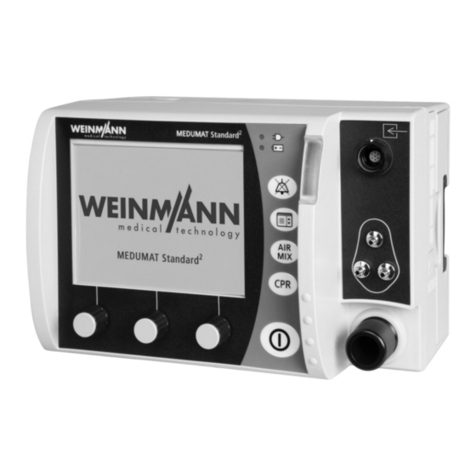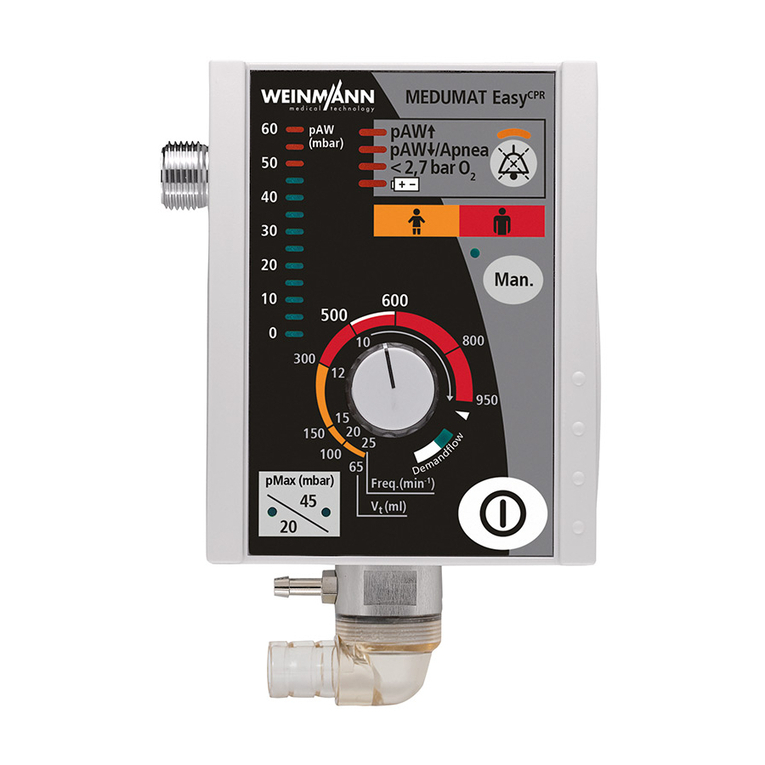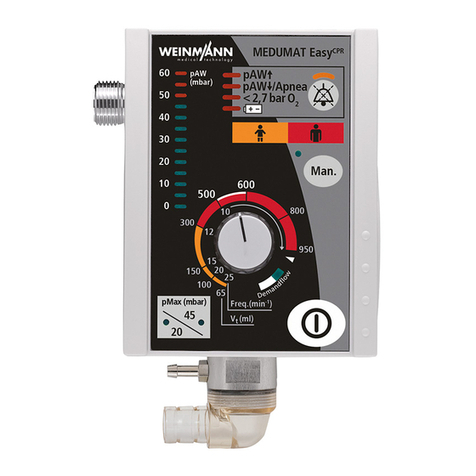
Contents
Introduction
. . . . . . . . . . . . . . . . . . . . . . . . .
3
1.
Overview
. . . . . . . . . . . . . . . . . . . . . . . . . . .
4
1.1
Special symbols on the ventilator
. . . . . .
5
2.
Description
. . . . . . . . . . . . . . . . . . . . . . . . . .
7
2.1
Uses
. . . . . . . . . . . . . . . . . . . . . . . . .
7
2.2
Ventilation function
. . . . . . . . . . . . . . . .
8
2.3
Demandflow function
. . . . . . . . . . . . . .
8
2.4
Patient valve
. . . . . . . . . . . . . . . . . . . .
9
2.5
Audio response
. . . . . . . . . . . . . . . . . .
9
2.6
Switching the metronome on and off
. . .
11
3.
Final check
. . . . . . . . . . . . . . . . . . . . . . . . .
12
3.1
Test material required
. . . . . . . . . . . . .
12
3.2
Preparation for the final check
. . . . . . .
13
3.3
Enter device data
. . . . . . . . . . . . . . .
13
3.4
Check for leaks and check
pressure display
. . . . . . . . . . . . . . . .
13
3.5
Self-test after the device is switched on
. .
14
3.6
Function check of controls (key test)
. . . .
15
3.7
Function check and alarms
. . . . . . . . .
15
3.8
Battery voltage
. . . . . . . . . . . . . . . . .
17
3.9
Function check of frequency setting
. . . .
18
3.10
Function check of
breath volume
at 4.5
bar input pressure
and 10
mbar back pressure
. . . . . . . .
19
3.11
Test O
2
concentration
. . . . . . . . . . . . .
20
3.12
Function check of pressure limit
. . . . . . .
20
3.13
Function check of venting valve without
patient valve
. . . . . . . . . . . . . . . . . . .
21
3.14
Test MEDUtrigger
. . . . . . . . . . . . . . .
21
3.15
Test communication socket
. . . . . . . . . .
22
3.16
Check external condition
. . . . . . . . . . .
22
3.17
Documentation
. . . . . . . . . . . . . . . . .
23
4.
Servicing
. . . . . . . . . . . . . . . . . . . . . . . . . .
24
4.1
Intervals and scope
. . . . . . . . . . . . . .
24
4.2
Batteries
. . . . . . . . . . . . . . . . . . . . . .
25
4.3
Storage
. . . . . . . . . . . . . . . . . . . . . .
25
5.
Troubleshooting
. . . . . . . . . . . . . . . . . . . . .
26
6.
Repair information and instructions
. . . . . . .
29
6.1
General
. . . . . . . . . . . . . . . . . . . . . .
29
6.2
Changing the filter in the pressurised
gas
connection
. . . . . . . . . . . . . . . . .
29
6.3
Open the device
. . . . . . . . . . . . . . . .
30
6.4
Close the device
. . . . . . . . . . . . . . . .
32
6.5
Replacing button cell
. . . . . . . . . . . . .
34
6.6
Changing the speaker
. . . . . . . . . . . .
35
6.7
Changing the board
. . . . . . . . . . . . .
36
6.8
Replacing the pneumatic block
. . . . . . .
37
6.9
Replacing the 3/2-way magnetic valve
.
39
6.10
Calibrating the potentiometer
(after changing pneumatic block
including
potentiometer)
. . . . . . . . . . .
40
6.11
Changing upper part of housing
. . . . . .
41
6.12
Changing the fascia film
. . . . . . . . . . .
42
6.13
Replace lower part of housing
. . . . . . .
43
7.
Spare parts
. . . . . . . . . . . . . . . . . . . . . . . .
46
7.1
Spare parts list
. . . . . . . . . . . . . . . . .
46
7.2
Service sets
. . . . . . . . . . . . . . . . . . .
48
8.
Tools and Test Equipment
. . . . . . . . . . . . . .
50
8.1
General tools
. . . . . . . . . . . . . . . . . .
50
8.2
Special tools
. . . . . . . . . . . . . . . . . . .
50
8.3
Testing equipment
. . . . . . . . . . . . . . .
51
9.
Technical data
. . . . . . . . . . . . . . . . . . . . . .
52
9.1
Pneumatic
/ electronic systems
. . . . . . .
53
10.
Technical Changes
. . . . . . . . . . . . . . . . . . .
54
11.
Repairs and maintenance protocols
. . . . . . .
55
© Copyright
WEINMANN GmbH & Co. KG.
The content and presentation are copyright protected and may only be used by authorised WEINMANN Service Partners in
the course of their service operations. The content must not be reproduced or passed on to third parties. The complete documents
must be returned on termination of the cooperation with WEINMANN.
































